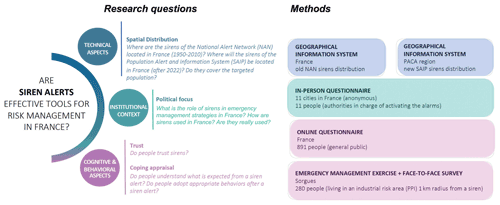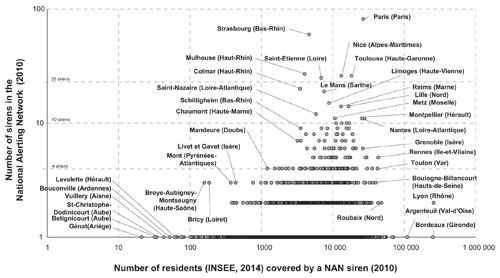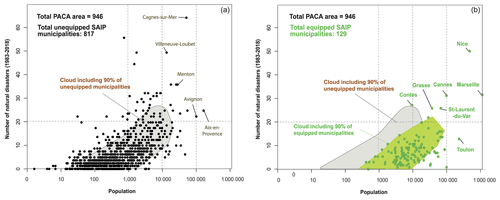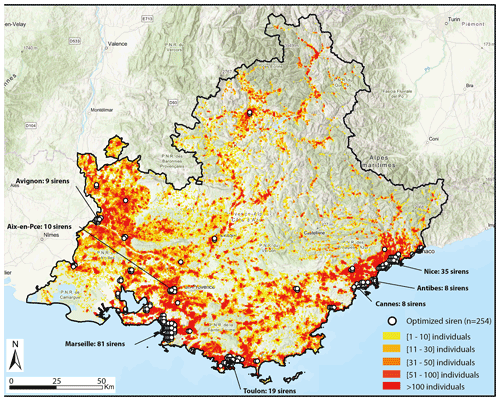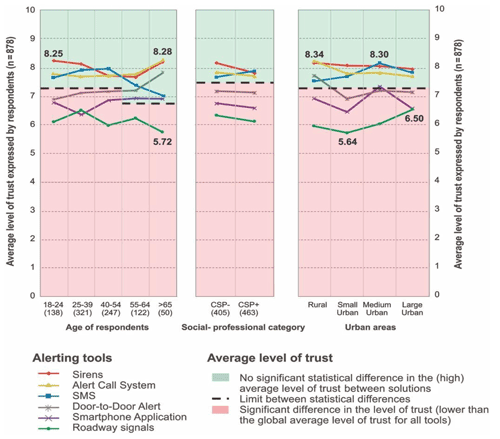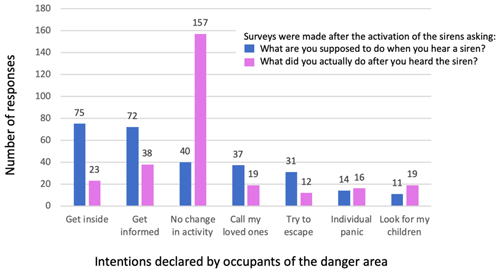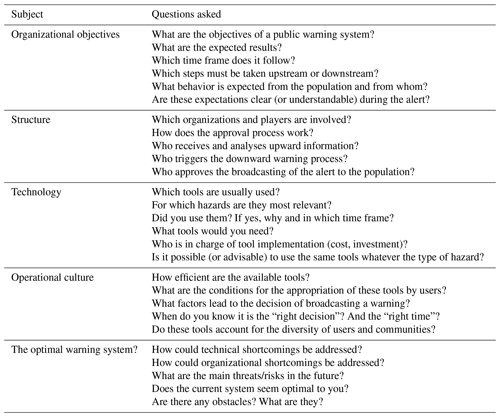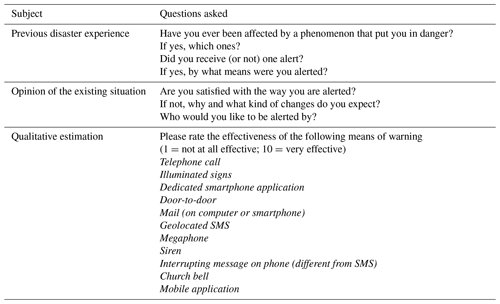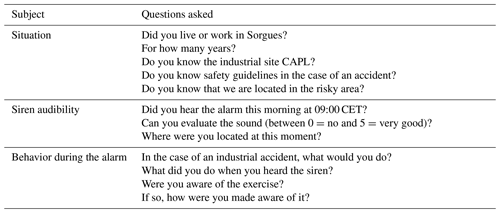the Creative Commons Attribution 4.0 License.
the Creative Commons Attribution 4.0 License.
Are sirens effective tools to alert the population in France?
Johnny Douvinet
Anna Serra-Llobet
Esteban Bopp
G. Mathias Kondolf
In France, sirens have been the principal tool designated to alert the population in the case of danger. However, their efficacity has not been objectively tested. Using a geographical information system, questionnaires, and surveys, we analyzed (1) the spatial distribution of the siren network in relation to the covered population, the hazards threatening different areas, and the actual number of disasters that have occurred in the past, (2) the political dilemma of activating sirens, and (3) the population's trust in sirens, as well as its understanding of expected behavior in the case of an emergency. Results show that, with a few exceptions, siren coverage in France is primarily determined by population density, not by the expected hazards or the cumulative number of past disasters. Sirens are also rarely used by the authorities. However, surveyed members of the population identify sirens as the most effective alert system over other alternatives such as cell-phone-based alerting tools. In a “mock” emergency most members of the public did not know how to respond in the case of an emergency, and even most of those who correctly identified the appropriate response prior to the exercise did not react upon later hearing the siren. To improve the effectiveness of the French siren network, we recommend (1) relocating sirens to optimize their efficiency, (2) complementing the sound of sirens with a clear and unified message, (3) reorganizing the competencies to activate siren alerts, and finally (4) improving public education on different alert tools and expected behavior during an emergency.
- Article
(18469 KB) - Full-text XML
- Companion paper
- BibTeX
- EndNote
Sirens are among the most widespread tools to alert a population to danger (Sorensen, 2000; Bean et al., 2016; Sättele et al., 2016; Stokoe, 2016; Mathews et al., 2017; Goto and Murray, 2020; Bopp and Douvinet, 2020). Sirens are intended to adequately warn citizens of threats or dangers to life or property, such as sudden mass hazards (earthquake, tsunami), rapidly occurring natural hazards (wildfire, flash flood), industrial accidents (toxic gas releases, explosions), or terrorist attacks, and can be implemented at the scale of entire cities (Singapore, Bombay, or Mexico City) or countries (e.g., Japan, France). Sirens theoretically present several advantages. They produce collective as well as individual reactions (Creton-Cazanave, 2010). They should allow authorities to quickly advise people and to implement countermeasures in a short response time (Douvinet, 2020). They are effective in alerting an entire population, day or night (Zunkel, 2015; Mathews et al., 2017; Landry et al., 2019), provided that the distribution of sirens is dense enough to be heard by all. Sirens leave no time for hesitation and require immediate reactions (Reed et al., 2010; Cain et al., 2021; Fekete et al., 2021). But their effectiveness is based on the implicit assumption that the population understands what is expected from them during the alarm (Sorensen, 2000; Linsday, 2011). For example, in regions of North America prone to tornadoes, a siren during tornado season is understood to indicate an impending event, and it is assumed that the alerted population knows the need to take shelter (Mathews et al., 2017). Mexico City has used sirens emitting a characteristic sound to alert residents when earthquake shaking is imminent (Coleman et al., 2011). These outdoor sirens are then a relevant part of the warning dissemination process since one siren may alert thousands of people even if they are not watching or listening to any type of mass media broadcast. However, where the population is less informed about risks (e.g., from flash flooding) or where sirens can be activated for different risks, they may be less effective, and the behavior expected from the people (to stay, to shelter, to leave, etc.) might be more ambiguous (Douvinet, 2018).
In France, despite changes at the head of the Ministry of Interior over the past 60 years, since the end of World War II the priority remains allocated to the sirens for alerting people (DGSCGC, 2013). A first network of sirens, the National Alert Network (NAN), was designed, as attested by an order signed in 1954 by General de Gaulle. Electronic sirens were foremost deployed to alert people to aerial threats, and a few years later, the order of 7 January 1959 defined responsibilities of the authorities responsible for the NAN activation (mayors, prefects, and the Ministry of Interior). The decree of 8 May 1973 expanded NAN use in the event of nuclear, bacteriological, and chemical risks, in relation to the development of the nuclear program in France in the 1970s. In 2010, 4189 NAN sirens were deployed in 2568 municipalities across France (Deloitte, 2014). But due to their age and failures in the activation, the French Ministry of Interior decided in 2010 to create a new network, presented as “more modern” and “more responsive”: the so-called SAIP (Système d'Alerte et d'Information des Populations), with a final target date of 2022. The distribution of the future SAIP sirens is based on the concept of risk area, “taking into account the population density, the speed of the process-creating hazards, the nature of risk, and specific circumstances (concentration of chemical industries for example)”, but no maps and statistics are available to confirm how these concepts were applied to develop the distribution of sirens. The distribution of the 5531 SAIP sirens was planned according to two priority levels (Vogel, 2017). A total of 640 high-priority areas are covered by 2832 sirens, and 1103 lower-priority areas are covered by 2699 sirens (Table 1). The siting of new SAIP sirens was guided by three objectives: (1) to connect sirens together, (2) to create a unique software, and (3) to improve the siren locations to reach a maximum number of people. But the areas and populations covered by the sirens is not publicly available information.
Several studies have raised doubts about the effectiveness of sirens and criticized the heavy investment in this technology in France (Hirel, 2002; Vinet, 2010; Garcia and Fearnley, 2012; Beccerra et al., 2013; Pappenberger et al., 2015; Daupras et al., 2015; Vogel, 2017; Douvinet, 2018; Courteau, 2019). Monthly testing of sirens (e.g., in France, the first Wednesday of each month) has served to remind residents of the existence of sirens (Créton-Cazanave, 2010), but a national study indicated that only 22 % of the population recognized the sound of alert sirens well enough to guide behavior (Deloitte, 2014). While sirens continue to receive new funding (EUR 83 million in 2010), the protocol for activating them remains largely unapplied (Vogel, 2017). Over the period 1959–2020, sirens were activated only five times: (1) during the 2014 Vidourle flash floods (3 casualties); (2) during the 2017 wildfires around Vitrolles, near Marseille (no victims but 2400 ha burned area and a cost exceeding EUR 1.3 million); (3) during the industrial fire in Lubrizol, near Rouen, on 26 September 2019 (there were only two sirens located less than 500 m around the fire); (4) during flash floods near Cannes, on 23 and 30 October 2019 (5 casualties). Nevertheless, many disasters did not result in sirens being activated, for example during the 1969 dam failure in Malpasset (421 victims) or in the situation of numerous flash floods, such as in Nîmes in 1988 (9 casualties), in Vaison-la-Romaine in 1992 (31 casualties), in Draguignan in 2010 (25 casualties), in Cannes in 2015 (20 casualties), in Trèbes in 2018 (5 casualties), and near Nice in 2020 (13 casualties). Siren activation is also limited when we consider all the dangerous situations that could require it (i.e., 3226 municipalities have been the subject of a natural disaster decree per year for floods over the period 1982–2018 for example; CCR, 2019). In part, this may reflect a reluctance to use sirens because of liability that may arise from a false alarm (such as occurred in Bastia in 2005, in the situation of a possible tsunami) and the related administrative penalties to officials who incorrectly sound the alarm (2 years imprisonment and a fine of EUR 30 000).
Table 1Number of sirens in the NAN network and in the SAIP project expected in 2022 (data from Vogel, 2017).

Underlying the reliance on sirens also makes the assumption that people are able to identify, recognize, and deal with hazards or threats, whatever their origins or how quickly they occur (e.g., flash floods). Other studies have demonstrated that few individuals are able to identify and understand dangers only by hearing sirens in France (Jagtman, 2010; Lutoff et al., 2016; Daupras et al., 2015). The sound of the siren is “one sound on top of others” (Dedieu, 2009) and is added to the ambient noise, particularly in urban areas. Decision-making becomes complex under stress because it involves cognitive and perception barriers (Becerra et al., 2013; Créton-Cazanave, 2010; Daupras et al., 2015). The interpretation of sounds depends on the knowledge and past experiences of each person, as well as the knowledge of those responsible for deciding to activate the alarm (Cain et al., 2021). In addition, these elements play a key role in the decision time before the reaction time (Colbeau-Justin, 2002; Daupras et al., 2015). It is impossible to produce a signal that triggers automatic behaviors (Roux, 2006), and the training of reflex takes time. A strong difference also remains in behavioral skills, between “I know what to do if something happens” and “I really apply the safety instructions when a danger occurs” (Weiss et al., 2011), and these lags prevail, independently of the type of the risk involved and of the types of alert messages (Cain et al., 2021).
In light of the limitations mentioned above our main research question is as follows: are sirens effective tools to alert people in France? To answer this question, we have analyzed (1) technical aspects related to the spatial distribution of sirens (Where are the sirens located? Do they cover the targeted population?), (2) the institutional context of using sirens in France (What is the role of sirens in emergency management in France? How are they used? Are they used?), and (3) cognitive and behavioral aspects related to the sirens (Do people trust sirens? Do people understand what is expected from a siren alert? Do people adopt appropriate behaviors after a siren alert?). To gain insights into these questions, we conducted a review of relevant literature in multiple fields, created a geographical information system (GIS) to analyze the spatial distribution of sirens in relation to population densities and location of potential hazards, and conducted surveys (Fig. 1).
Data and methods developed in this article draw upon research conducted since 2016. However, all tables and figures in this article are original. In previous research, the method to calculate the number of residents living around sirens (Douvinet, 2018) and the questionnaire addressed to prefects and mayors (Bopp et al., 2021) were not yet addressed at a local scale, while this article coupled new results obtained at the national scale. Combining quantitative research and displaying results in new tables and figures allowed us to have a more comprehensive assessment of the situation of siren alerts in France.
First, to assess the spatial coverage, we applied tools that combine data collected using a GIS with information collected for each municipality (the number of inhabitants in 2014, the number of natural disasters over the period 1983–2019, and the number of registered risks). We created a geodatabase to provide an overview of the siren coverage and to assess various factors that could explain the location of the current and the future siren system. This allowed us to identify areas equipped and unequipped with sirens and estimated populations covered. Second, to analyze the political dilemma (activating the siren or not), we analyzed operational reports and created an in-person questionnaire to evaluate the functionality and usability of sirens for authorities in charge of “turning them on” (prefects and mayors). Third, to assess if the population trusts sirens and to evaluate the effectiveness of the alarms in relation to perception and behavioral aspects, we created an online survey and observed applications of safety guidelines during an emergency exercise.
2.1 Spatial distribution of sirens in France
2.1.1 Where are sirens located in France?
The location of the 4189 NAN sirens was provided by the French Ministry of Interior in a shapefile format in 2017. Then, we located the 2568 equipped municipalities, and we used the municipal population census of 2010 to obtain a first estimation of the population living in equipped or unequipped cities. Such figures are not an ideal choice as neither the patterns of location of people at finer scale, the influence of environmental factors in the sound propagation (Mathews et al., 2017), nor mobility of residents are considered. But with these first estimates, we wanted to identify which kinds of areas were equipped (urban cities? rural areas?) and which were not to detect over- or under-endowed cities and to calculate at national scale the part of residents theoretically covered. We compared the number of natural disasters and the number of risks, both provided by the Ministry of Environment (for 2014), for the equipped and unequipped cities to evaluate the influence of risks or past disasters on the distribution of sirens. The number of natural disasters, registered in the national CatNat database (1983–2010), is a potentially relevant variable because a municipality that has suffered significant damage as a result of a natural phenomenon may request classification of the event as a “natural disaster” in France (Vinet, 2010; Douvinet and Janet, 2017). The number of risks, registered in the DDRM (Dossier Départemental des Risques Majeurs, Major Risk Synthesis) database (available in each prefecture), refers to the idea that a municipality needs to map and to inform the population about risks in the living zone. We used the Spearman correlation coefficient as a measure of a positive or a monotonic relation. This is the first time that such an analysis using this spatial information has been reported in France.
Due to the confidential nature of databases, we cannot present maps expected for the future SAIP network over all of France. However, we have the consent of the French Ministry of Interior to address this analysis in the PACA (Provence–Alpes–Côte d'Azur) region, in southern France, covering 31 400 km2 with an estimated population of 5 029 214 inhabitants in 2016 (INSEE, 2018). The population has doubled since the 1960s (2 414 958 inhabitants in 1954) mainly due to tourism and immigration from elsewhere in France and abroad. Two thirds of residents live in four major urban cities (Marseille, Nice, Toulon, and Avignon). Eighty percent of the population is located in coastal areas, while mountainous and rural areas in the Alpine regions are sparsely populated. The precise location of the future SAIP sirens was provided by the French Ministry of Interior in a shapefile format in 2019. Then, we located the future 254 SAIP sirens and compared them with the older 304 NAN sirens. We thus analyzed the previously NAN-equipped municipalities (without SAIP sirens), the newly equipped sites (with SAIP), and areas where NAN sirens will be included in the future SAIP network, and we estimated the evolution in covered population. One indicator, the Gini index (Atkinson, 1970), was estimated to detect levels of inequality between municipal estimates. These Gini values may vary between 0 (a perfect equality with identical values for the overall population) and 1 (extreme inequality, with values equal to 0, except for one individual); between 0 and 1, the higher the Gini index is, the greater the inequality is. In addition, the Moran index was also calculated (Moran, 1950). Negative Moran indexes indicate a negative spatial autocorrelation, and values range from −1 (indicating perfect spatial dispersion) to 1 (perfect correlation). A zero value is significant for a perfectly random spatial pattern.
2.1.2 Do sirens cover the targeted population?
Sirens may broadcast a similar sound in France but with various intensities (from 114 dB to a maximum of 126 dB), various frequencies, and various powers (from 1 up to 7 kW). Siren locations were available in a shapefile, but the power of the sirens was indicated for only 32 % of sirens, and the date of installation was available for only 28 %. According to the manufacturers, sirens should be audible in all directions (360∘) over a distance of 4.5 km with a power of 7 kW, but our field tests indicated that the siren sounds could not be heard beyond 1 km (Douvinet, 2018). The actual radius of audibility around sirens is a function of sound propagation, which besides strength of the emitted sound also depends on factors like the strength and direction of winds, temperature, air density, nature of materials used for construction, and the ambient sound (Zunkel, 2015; Mathews et al., 2017). While the audibility distance for a siren with a power of 7 kW is considered to be up to 3 km, sirens may also be inaudible beyond a distance of 800 m from the source point even under ideal conditions. Audibility would be much less for weaker (1 kW) sirens. Energies between two sirens can be disturbed if they are not far enough apart: for example, for a 4 kW siren the spatial distance needed to be respected is 2.1 km in a calm urban environment and 0.57 km in a densely urban area (Deloitte, 2014). In selecting a constant radius of audibility to use in our spatial modeling, we chose a 1.4 km radius based on prior studies (Bopp, 2021; Reed et al., 2010; Zunkel, 2015; Mathews et al., 2017), assuming a 7 kW siren and accounting for attenuation and ambient sound volume (Aumond et al., 2017). Using the population density with a square mesh with tiles of 200 m sides, we calculated the population covered in the 1.4 km optimized radius. The population included in the radius of a siren was proportional to the area of the related circle (Mathews et al., 2017). This new estimate of population covered could be compared to the total population living in the cities equipped with sirens.
2.2 Institutional context: assessing the siren activation dilemma
2.2.1 What is the role of sirens in emergency management in France?
We compiled and reviewed literature (including operational reports) on major disasters in France over the period 2000–2020, especially after the flash floods occurring in 2010, 2015, 2018, and 2019 and the industrial accident in Lubrizol in 2019, to ascertain why sirens were used (or not) during such events. We took into account political legacy, social practice, the nature of the risks, and how well sirens were adapted to their environment (Donaldson, 1996). Many studies have shown that use of sirens is contingent on political, economic, social, and environmental factors (IBZ, 2017; Bopp et al., 2021). But what about organizational aspects such as procedures, type, number of actors or responsibilities to disseminate the alert, hazard-detection modes, communications modes, and interactions with crisis (Bopp et al., 2021)? To answer this, we studied two ideas: (1) the siren activation depends on the structure and inherited political governance more than the nature of risks or the impacts of disasters; (2) the location of SAIP sirens (in progress since 2010) still depends on political choice more than risk awareness and type of disasters.
2.2.2 Governance: how are sirens used in France? Do authorities really use them?
In addition, to complete the responses to the previous hypotheses, in 2020 we conducted semi-directive interviews (N=11), by phone (due to the COVID-19 context), with prefects (4) and with actors (7) representing mayors in France. The four prefects were selected with the support of the French Ministry of Interior and the other actors via scientific and operational relations. All of them gave their consent to participate in the study, on a basis of anonymity, following the requirements of the French GDPR (General Data Protection Regulation) adopted in 2016. Interestingly, these actors play different roles in accordance with the level of government administration at the national, departmental, regional, and even at the municipal level. The sample (so-called S1, see worksheet in Appendix A) focused on the same topics identified in our review of literature and operational reports: the organizational objectives (what were the objectives of sirens and which steps must be undertaken for their use?), the alerting structure (how does the approval process work and who triggers the siren?), the tools actually used (for which hazards are sirens used and did the authorities use them?), and the operational culture (how efficient are the sirens and what factors led to the activation?). Indeed, we wanted to collect their opinions on the place of sirens in their emergency alert strategies and to compare them with the operational review we carried out in the first step. This qualitative analysis was mainly focused on further exploration of unique and specific findings in relation to the roles, functions, and contributions of actors during the alerting process, but the small sample size did not lend itself to statistical analysis.
2.3 Behavioral aspects: measuring awareness and trust in sirens for citizens
2.3.1 Do people trust sirens?
A second sample (S2) involved 891 respondents (441 women; 434 men), aged 18–80 years old (mean M=39.90, SD = 14.81), who completed an online questionnaire in 2019 (see Appendix B). We created this questionnaire to predict whether the location-based alert system (LBAS, like cell broadcast or location-based SMS) could be useful in France (Bopp and Douvinet, 2020). Relevant to the present paper, the questionnaire asked respondents to rate a range of warning devices (including sirens) from 1 (not effective) to 10 (very effective). We analyzed results according to respondents' social characteristics (age, socio-professional category, having experienced a disaster or not) and territorial factors (type of urban area) using an ANOVA (parametric data). All the 891 persons gave their prior consent to take part in this research, respecting the GDPR protocol. The profile of the respondents indicates an over-representation of those with a higher-graduate (with master's degree) diploma (+29.5 %), students (+11.0 %), and individuals aged from 25 and 54 years old (+13.4 %), according to data currently available in France, and an under-representation of retired people (−18.6 %), those with a lower-graduate diploma (−10.6 %), and people without professional activities (−9.2 %), which could be attributed (at least in part) to the use of the Internet for such a survey (Divard, 2009). The age distribution of participants presented (138 were 18–24 years old, 321 were 25–39 years old, 247 were 40–54 years old, 122 were 55–64 years old, and 50 were > 65 years old) is similar to the age distribution of the country as a whole. The largest group of respondents (508, 61 %) lived in large urban areas, while 124 were from medium urban areas, 128 were from small urban areas, and 118 were from rural areas. We used the Gini index to indicate the level of inequality in the distribution of values.
2.3.2 Do people understand what is expected and adopt appropriate behaviors after a siren alert?
To answer this question, we followed a civil security exercise in December 2016 in Sorgues, a small city immediately north of Avignon (Fig. 2) (see worksheet in Appendix C). We administered a questionnaire to assess the perception and the understanding of the alert to 280 persons (147 women and 133 men) aged 19–81 years old (M=55.67, SD = 12.25) who were present in this risky area (so-called the Plan Particulier d'Intervention perimeter in French) during the civil exercise. All the participants gave their written consent prior to taking part in this exercise. We asked each participant “What do they think to do in the case of an industrial accident” (Q1), and just a few minutes later, we asked them “What they had just done after hearing the siren sound at 09:00 CET that morning?”. Some students (12) observed the exercise and addressed the questionnaire in some places (10) located around the industrial site, in less than 1 km radius of the sirens, which were activated at 08:45 and 09:15 CET. We analyzed responses quantitatively and estimated the correlations between signal detection and reaction variables using bivariate analysis. This sample (S3) was not conducted to assess a representative survey on behaviors during sirens, but it enabled us to quantify the differences between knowledge of appropriate behaviors (“I know what I have to do”) and the real reactions people have a few minutes after the activation of alerts (“I do what I really understand about the situation”).
2.4 Methodological limitations
Methodologically, the techniques for collecting surveys by teleconference (due to the COVID-19 context) and in-depth interviews created opportunities for data bias. While respondents described their perception of sirens, the interpretations are collected after events and not before, so this may introduce bias. It was also impossible to seek a demographically representative sample of the population using online and face-to-face questionnaires. Moreover, wording and order of questions play a role in the way individuals respond (Budd, 1987; Davis and Venkatesh, 1996). Furthermore, there is commonly a bias between what individuals report and the reality. We have already proven a recurring mismatch (Douvinet, 2018, 2020) between behavioral duties (what individuals declare they know how to do) and the behaviors actually observed in times of crisis, agreeing with other work conducted in psychology (Weiss et al., 2011). In addition, this study focused on the spatial location of sirens but fine-scale studies of responses to siren activation for recent events was precluded by ongoing judicial procedures.
3.1 Prioritizing densely populated cities
3.1.1 Spatial inequalities in the current NAN sirens coverage
The mapping of the 4189 NAN sirens (Fig. 2) showed a strong relationship between the siren location and densely populated cities. 41 % of large, densely urban areas were covered by at least one siren (1299 municipalities over 3171) and numerous sirens were located in the Île-de-France region (Paris), equipped with 82 sirens, in Strasbourg (60 sirens), Marseille (57), Lyon (28), Toulouse (27) or Nice (26). A total of 15 cities (out of 22) with more than 100 000 residents were equipped with more than 10 sirens. The percentage of equipped rural cities with sirens was the smallest (1.4 %), and the rate in small urban areas (4.7 %) was likewise low. The small number of NAN sirens in peri-urban areas (4.1 %) probably reflects the proliferation of such areas in France, but this suggests that the NAN siren coverage was poorly adapted to the evolution of urbanization as it sprawled over the last 60 years. Sirens were mounted on top of town halls (26 %, 67 % in densely urban areas), on roofs of churches (14 %, 5 % in rural areas), on other administrative buildings (28 %), and on poles placed along streets or buildings (32 %).
Consequently, the NAN coverage was spatially unequal: 7.4 % of the total number of municipalities are equipped (Table 2). Of the 52.6 % of the French population living in an equipped municipality, most were located in large, densely urban areas: 77.3 % of this urban population (30 million people) was covered. Of the French population living in medium-sized urban areas, only 54.4 % was covered by sirens, while only 20.4 % of those in small rural areas were covered, and only 4 % of the population registered in rural areas really lives within sound of a siren (Table 2). The low percentage of coverage in peri-urban areas around major cities (14.7 %) reflects the difference between the NAN location, and the progressive evolution of urban settlement over the last 60 years. Unfortunately, other statistical analyses are impossible as the date of siren installation is only known for 32 % of NAN sirens.
Table 2Overview of equipped and unequipped municipalities and populations living in equipped areas by the 3171 National Alert Network (NAN) sirens in France in 2010 in relation to different urban density areas (INSEE, 2014).

a A group of municipalities, in a single block, consisting of an urban unit center with more than 10 000 jobs. b Peri-urban municipalities in which at least 40 % of the employed residents work in large and densely urban areas. c Urban units with 5000 to 10 000 jobs and rural urban areas in which at least 40 % of the residents with a job work in urban areas. d A group of municipalities, in a single block, consisting of urban units with 1500 to 5000 jobs, or rural areas where at least 40 % of the residents work in urban areas. e Municipalities outside urban areas.
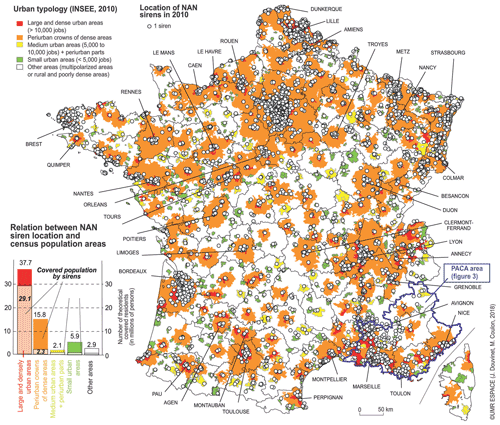
Figure 2Distribution of the 4291 sirens of the National Alert Network (NAN) in France related to the urban areas.
When studying the relationship between the number of NAN sirens and the part of the population covered by a siren, a few medium-sized cities appear over-equipped (27 sirens in Mulhouse, 26 in Saint-Étienne, 20 in Colmar, etc.), as well as several small rural cities (Fig. 3). Among the small municipalities equipped, 64 present a population of less than 500 persons. Three sirens were located in Broye-Aubigney (Haute-Saône), a village with only 477 inhabitants but exposed to earthquake and flood risk, and at Bricy (Loiret), a village with 557 inhabitants, exposed only to flood risk (located in Fig. 3). In these villages, the low population would not normally justify the presence of alert sirens, but the gravity of risks was evidently the basis for locating sirens there. In contrast, several densely populated cities, for example Lyon (two sirens for 515 685 inhabitants), Bordeaux (one siren for a city of 252 040 inhabitants), or Argenteuil (one siren for 110 468 residents), appear to have been inadequately provided with sirens (Fig. 3). Thus, while the NAN spatial coverage was influenced first by population density with a priority to larger urban areas, this was not the only consideration accounted for. Other factors influenced the NAN coverage, such as proximity to strategic military sites (explaining the high number of sirens near Brest and Toulon for example; Fig. 3), proximity to frontiers (near Germany or Belgium, with sirens first deployed after World War II), and concentration of industrial areas in several valleys (along the Rhine and the Rhone valleys for example). Locally, or for small villages, the existence of sirens is identified as a result of choices that are not very explicit (Kuligoswki and Dooston, 2018; Matthews and Ellis, 2016).
3.1.2 Spatial inequalities reinforced in the PACA region with the new SAIP network
Mapping the spatial evolution induced between the NAN sirens (304) and the future SAIP sirens (254) in the PACA region confirms that the relocation of sirens is evolving even more in favor of densely populated, large cities. The number of sirens decreases in some urban areas, but at the same time, they have been relocated to even more populated cities (Fig. 4a), around Marseille (+12 sirens), Toulon (+6 sirens), Étang-de-Berre (+13 sirens), and Saint-Tropez (+5 sirens). Interestingly, the number of residents living in equipped cities will not significantly decrease: the SAIP sirens will cover 58.54 % of the population, with 254 sirens, against 59.54 % covered with the 304 older NAN sirens. The 101 new SAIP sirens will benefit the two most populated departments in the PACA region: Bouches-du-Rhône (+44) and Var (+40). However, the decreasing number of NAN sirens appears important in several outlying urban areas, especially in the hinterlands of the Marseille and Nice regions and in the Vaucluse region (−58, against +1 new SAIP siren). In this department, the previous NAN network, composed of 85 sirens (which covered about 386 100 residents within a 3 km radius), will be replaced by only 27 SAIP sirens, covering 285 000 residents in the 3 km radius. The grey-colored circles (Fig. 4) localize the removed NAN sirens that will not be incorporated in the SAIP network, and municipalities shall maintain or remove these sirens or recover them on their own behalf, with funding provided from their own resources. In addition, the correlation coefficient (Spearman) is higher between the SAIP sirens and the population (ρ=0.59) than between the NAN sirens and population (ρ=0.46).
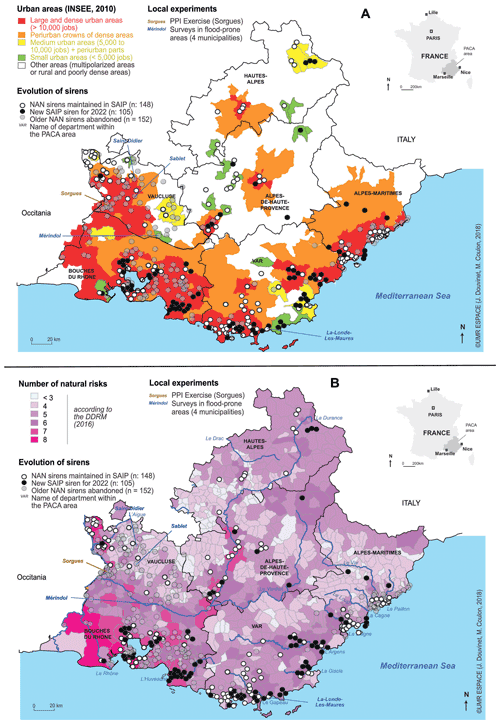
Figure 4Evolution between the NAN and SAIP networks in the PACA region (Provence–Alpes–Côte d'Azur), related to (a) the urban typology and (b) the number of natural risks indicated by the French Ministry of Environment.
Table 3Overview of the rate of SAIP- and NAN-equipped municipalities and populations living in equipped areas by the 254 future SAIP sirens in the PACA region in relation to different urban density areas (INSEE, 2014).

a A group of municipalities, in a single block, consisting of an urban unit center with more than 10 000 jobs. b Peri-urban municipalities in which at least 40 % of the employed residents work in large and densely urban areas. c Urban units with 5000 to 10 000 jobs and rural urban areas in which at least 40 % of the residents with a job work in urban areas. d A group of municipalities, in a single block, consisting of urban units with 1500 to 5000 jobs, or rural areas where at least 40 % of the residents work in urban areas. e Municipalities outside urban areas.
3.1.3 Siren location is not related to the number of risks, past disasters, or prevention plans
Studying the number of natural risks in equipped or unequipped municipalities in the PACA region (Fig. 4b) indicates that number of risks or past disasters does not influence the location of sirens. The contrary could be expected given that the 304 NAN sirens were located by priority within municipalities presenting five (103) or six (61) risks and that several SAIP sirens will cover a further number of people living in cities characterized by seven natural risks (1.04 million people compared to 0.43 with the NAN network; Fig. 5). New SAIP sirens will also exist in several cities recently affected by flash floods, along the Argens River (+11 sirens; 25 victims, 15 June 2010), and around Cannes (affected by two flash floods; 20 victims, 3 October 2015; 7 victims, 23 November 2019) for example. However, the increasing number of covered populations in municipalities presenting seven risks (+0.59 million people with SAIP) and eight risks (+0.20 million people) is mainly due to the fact that new sirens will be planned in highly populated areas. While 38 NAN sirens covered 0.43 million people, the future SAIP system will only exist in 18 cities, including 15 cities with more than 20 000 inhabitants (Fig. 5). The covered population in municipalities where five or six risks exist decreases (1.43 million people with SAIP against 1.98 with the NAN sirens), as well as the number of equipped areas (82 in the SAIP network against 164 in that of the NAN). Many municipalities with five () or six risks () are still unequipped. The correlation coefficient between the number of SAIP sirens and the number of risks (ρ=0.32) remains low and is not really better than those obtained with NAN sirens (ρ=0.31).
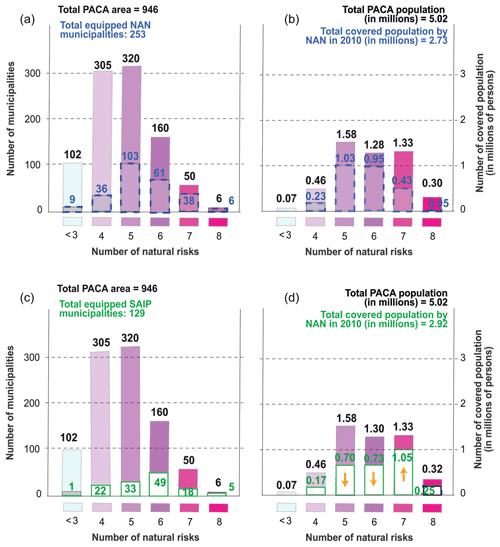
Figure 5Covered municipalities and number of risks for the NAN (a) and the SAIP (b) sirens, according to the DDRM (2016) in the PACA region.
The weak correlation between the number of recent natural disasters (1983–2020) and location of sirens in the PACA region may have negative consequences for risk management. Even if equipped areas have an average number of natural disasters (10.3 over 37 years) higher than for those unequipped (5.12), no significant differences are observed (Fig. 5). The correlation coefficients with the number of SAIP (ρ=0.32) and NAN (ρ=0.29) sirens are also limited due to the scattering of values. This trend is similar at national scale with the NAN sirens (ρ=0.21) but remains unknown for the future SAIP network. Moreover, a relevant correlation between the number of inhabitants and the number of natural disasters exists (ρ=0.67 in the PACA region and ρ=0.78 in France), as well as a relation between damage and the creation of risk prevention plans (Vinet, 2010) or with the Municipal Response Plan (Pottier et al., 2004). Thus, the statistical correlations between risk parameters are not related to the location of sirens. This trend is reinforced by a recent study in the Vaucluse department, which showed that 100 % of small basins (of less than 5 km2) sensitive to flash floods were excluded in the 3 km radius of sirens (Douvinet, 2020).
3.1.4 Relocating sirens to optimize their efficiency?
Regarding the spatial location of the sirens, we developed an alternative placement strategy for sirens to cover the maximum population at a communal scale. With GIS tools, we created a regular grid in which each square has a length and width of 1060 m; i.e., it is circumscribed within a circle of an audible radius of r=1413 m. We counted the number of individuals in each square and selected the 254 most densely populated squares in the PACA region (corresponding to the number of future SAIP sirens planned). With this method, 47.88 % of the population would be alerted in the South PACA region, 9.69 % more than with the current location of the SAIP sirens. Another option would be to have 1000 sirens distributed over the highest density urban areas. In that case 74.53 % of the population could be alerted. However, this option would accentuate the location of the sirens in densely populated cities such as Marseille (81 sirens), Nice (35 sirens), Toulon (19 sirens), Aix-en-Provence (10 sirens), Avignon (9 sirens), Cannes (8 sirens), and Antibes (8 sirens) (Fig. 7). However, this option makes the siren placement exclusively urban, thereby ignoring less densely populated areas that are also exposed to risks. So authorities would have a more complicated choice to make.
3.1.5 Lower rates of coverage at finer scales
Estimating the number of people living in the 1.4 km optimized radius around sirens showed additional “holes in the racket” because coverage rates are lower than the first estimates. In the PACA region, the older NAN sirens covered 32.4 % of residents in the 1.4 km radius (whereas 58.54 % of the population lived in equipped cities), and this estimation increases to 38.2 % with SAIP sirens (while 59.54 % of the population is living in equipped cities). We calculated coverage values for 1 km (24.6 % of residents), 2 km (40.5 %), and 3 km (48.5 %) buffers. Thus, the statistic “number of people living in equipped cities” overestimated the real siren coverage. In addition, more than 3.1 million inhabitants cannot be alerted by SAIP sirens in the PACA region, and the average coverage rate for the equipped municipalities is 58.1 %. The first quartile is 29.8 %, the third 83.8 %, and only two municipalities have 100 % of their population included in this 1.4 km optimized radius (with respectively 428 and 5766 inhabitants) out of the 129 equipped cities. Then, if we translate these figures differently, this means that a quarter of the cities equipped with SAIP sirens can alert less than 30 % of the resident population. The strong spatial inequality is supported by the Gini index of the rates of individuals covered, equal to 0.87. Moreover, the Moran autocorrelation index is 0.22, which means that the number of individuals covered by sirens tends to be close between neighboring sites. This inequality becomes all the more significant when we classify the municipalities according to the type of urban area to which they belong. Only 6.9 % of people living in communes outside urban areas can be alerted, whereas 46.8 % of people living in small urban areas, with less than 50 000 inhabitants, can be alerted. The difference equals 39.9 %, and this is due to the greater sprawl of housing and the scale effect played by the size of the dispersed cities.
3.2 Activating sirens: the political dilemma
3.2.1 The industrial accident in Lubrizol (2019): an iconic example
This accident occurred on 26 September 2019 in the Lubrizol site (near Rouen, Fig. 1), and it is the most recent event that has led to several public reports in 2020 (Bonfanti-Dossat and Bonnefoy, 2020). But this first revealed the vision that the practitioners can have during the crisis. Earlier in the morning, at 02:40 CET, a violent fire was reported on the site, and a crisis center was quickly put in place (at 03:30 CET). The prefect of Seine-Maritime informed people of the situation on social networks (at 04:50 CET) and through press releases (06:15 and 06:45 CET). But two sirens located less than 500 m around the site were not activated until 07:45 CET, more than 5 h after the accident began. As explained by the prefect, the delay resulted from (1) fear of creating a panic reaction if the sirens had sounded during the middle of the night; and (2) fear of having to manage an anarchic evacuation when the issue was to avoid the slightest congestion on the road network to facilitate access for rescue and emergency services. Sirens were then activated to support containment instructions (to be sent out previously by press briefing). However, sirens were not intended to reveal the fire that had already been identified and communicated by the authorities, and such a point of view is currently observed in the other operational reports analyzed. The siren's activation indicates to the population that the situation has been taken into account by the authorities but is not used as a means of alert (similar to their role during the Cannes flash flood in 2015). The “fear of panic” was already put forward in discourses on the non-use of sirens (Vogel, 2017). However, researchers have discredited this “myth” for many years (Sorensen, 2000), pointing out that in the face of danger, mutual aid and the search for proximity to familiar people and places predominate rather than chaotic and unreasonable movements (Liu et al., 2015).
3.2.2 An activation only justified by political decisions
A second problem, recurring in the reports and questionnaires (S1), is that actors involved in issuing sirens have had the same reference systems for decades (Courteaux, 2019). We could expect that the siren activation is influenced by the national context or crises that have occurred in the past, in the last months and also in the last years, which may contribute to either the transformation or the improvement of the national alerting system. But the siren activation is still vertical, “top-down” marked, and although a longitudinal approach is challenging, the pyramid approach remains predominant. During the reported flash floods, no sirens were activated due to lack of anticipation (2003, 2008, 2010, 2015) or lack of electricity (2018, 2019) despite the existence of several sirens in areas impacted by the flash floods. No lessons were learned from the past. Moreover, the procedure itself is not “apolitical”: the French government advocates for sirens to justify the funding allocated to them (Matveeva, 2006), and they present them as a “good tool (We did the best we could)”, while they were only used three times since the beginning of the 2000s (during a fire in 2014; a flood in 2017; an industrial accident in 2019). Second, what might be termed a “technological fetishism” for sirens led to the abandonment in 2018 of the so-called SAIP mobile application, set up by the French Ministry of the Interior in 2016. While similar mobile phone applications have been successfully employed in other countries, its performance in France was disappointing. For example, it was not activated during terrorist attacks in Nice in July 2016 nor in Saint-Étienne-du-Rouvray in 2017, though it was activated for a false alert in the Louvre in Paris. Other technical devices exist and are well suited to end users, for example “kidnap alert” (inspired by the amber alert system set up in the USA in 1996) or motorway warning systems that combine technical and social dimensions. The technical references prevent any organizational change. Indeed, one may wonder about the efficiency of sirens in comparison to a system that could send thousands of messages in a few seconds, if sirens are not adapted to the kinetics of the event or if they are not understood by those who receive the alert, or if it takes hours for the authorities to make the decision to send the alert. France has made a bold choice, but the resulting choice, based on control-and-hierarchical command, can be questioned in terms of its real capacity to alert communities in good time.
3.2.3 Where sirens exist, authorities also prefer not to use them
In addition, in the sample S1, 7 of 11 authorities responding to our interview assumed that one of the objectives of sirens is only to warn the greatest number of people in the area threatened by danger or risk so that the population can be aware of probable impacts. For them, sirens should provoke the population to seek information in the case of fires, floods, or bombing. Of the 11 authorities responding to our questions, seven highlighted the importance of prior experience and feedback to know corrective measures to be implemented and to check coordination among the actors involved even if this means establishing synergies (by creating “gateways” for example). But six respondents observed that lessons learned from past events have not been sufficiently shared. Other respondents said that tools should not be differentiated according to hazards or the social conditions, highlighting that sirens would likely be better understood by elderly individuals than social media without evidence for whether this would actually be the case. Discussions with these actors who had actually activated sirens in recent years highlight two contradictions in the current procedure: (1) “we activate the alarm to comply with the regulatory framework, knowing that the sirens will have a limited range”. In other words, this strategy is comfortable for authorities who “cover up” to avoid problems later on (during post-event investigations in particular); (2) “the difficulty is that it is necessary to alert locally with available means, while benefiting from a robust architecture at the national level”. Thus, the SAIP network is a positively perceived solution, while sirens do not exist everywhere.
3.3 The dichotomy between trust in sirens and reaction during siren alert
3.3.1 A blind confidence in sirens
The second sample (S2), using an online questionnaire (2019), allowed us to evaluate the population's trust in sirens in comparison with other dissemination tools, like cell broadcast or location-based SMS (CBC/LB-SMS). Sirens remain the most trusted tools for the 891 respondents (Fig. 8), whereas just after violent events, they declared that they do not understand the usefulness of such tools. The siren scored the highest average () ahead of a CBC/LB-SMS solution (), the automatic telephone call system (), door-to-door (), and the smartphone mobile application (). Scores are homogeneous as the Gini index (GI) equals . In addition, social-territorial factors are not decisive in the notes given to the siren. There is no significant difference according to the age of participants (P=0.077), the urban area to which their residence belongs (P=0.794), or the individual's experience facing disasters (P=0.921). However, the siren is rated better by individuals belonging to a lower socio-professional category (SPC) than individuals belonging to a higher socio-professional category (P=0.031). Above all, compared to other means of alerting, the siren remains significantly more accepted, undoubtedly attributable in part to monthly testing. Respondents did not know that only 18 % of cities in France are equipped with sirens and that many NAN sirens are disappearing.
3.3.2 Lack of reactions during real siren alert
The last sample (S3) conducted in Sorgues (see location in Fig. 4) also reveals the difficulty that people have in the case of real siren alert. A total of 72 persons (out of 280) declared that they would inform themselves in the situation of an alert, 75 reported that they would get inside a building, 37 said they would call their relatives, and 40 do no change their activity. However, during the real activation of sirens, while they heard the sound, most (157) continued their activities at the time of the signal (Fig. 9). Only 23 attempted to enquire about why the alert had activated, 38 got informed, 16 panicked, and 12 tried to escape without knowing why. These results reveal that behavior is clearly out of step with declarations (Vinet, 2010; Weiss et al., 2011; Gisclard et al., 2017; Douvinet, 2020). People face difficulties in making decisions in real time, like picking up their children from school or not or driving (Créton-Cazanave, 2010; Ruin et al., 2007; Kuligowski et al., 2014). The question could be asked whether it is useful to add an anxiety signal at a time when individuals are already stressed. Thus, assessing the utility of sirens in such cases requires a good knowledge of the nature and urgency of the danger, which is not always predictable (as with terrorist attacks or industrial accidents), and these limitations will persist with the future SAIP system.
The study of spatial, political, and social aspects related to the siren network to alert the population in the case of an emergency shows several challenges that need to be addressed to increase their real efficiency. Results show that the distribution of sirens in France is related to the population density, not to the number of hazards or past disasters that have impacted a region. Furthermore, not all the population is covered by the sirens. In France only 7.4 % of cities were equipped with sirens from the old NAN (National Alert Network) system, and, in the PACA region in particular, only 38.2 % of residents are living in the 1.4 km radius around sirens from the new SAIP (Population Alert and Information System). Where sirens exist, they are rarely used either due to the lack of reaction time during sudden events or the reluctance of the authorities to activate them to avoid chaotic reactions from the population or liability issues in the case of a false alarm. Sirens have only been used three times since 2000 (and six times since 1954) in all of France, leading some to question the budgets allocated (more than EUR 50 million were allocated for the SAIP in 2010). Nonetheless, citizens, accustomed to hearing the siren test on the first Wednesday of every month, express marginally greater confidence in sirens as a tool to alert the population over other options such as smart-phone applications. However, the lack of a specific message linked to the sound of the siren can create confusion and unpredictability in the behavior of residents during an emergency, and our research demonstrates that in the case of a real crisis, very few people react when they hear it. In light of these limitations, we recommend changes (technical, organizational, and cognitive) in the implementation of the new SAIP siren system, expected in June 2022 across France.
The sound of sirens should be complemented with a clear unified message so that members of the population understand the expected behavior (Reed et al., 2010; Cvetkovića et al., 2019; Cain et al., 2021). The December 2018 directive establishing the European Electronic Communications Code requires member states to establish a national SMS alerting system by June 2022 (Vogel, 2017; Bopp et al., 2021). Countries such as Italy, Norway, Germany, and Romania are using the Common Alerting Protocol (CAP) to increase the alert effectiveness as the protocol allows an alert message to be consistently disseminated simultaneously over many warning systems to many applications, such as cell phone broadcast (Bean et al., 2016; Landewr et al., 2016; Leo et al., 2015; Mileti and Sorensen, 1990; Vinet et al., 2011). This can allow the integration of sirens with other tools. This path is promising, but at the time of writing, it is unclear whether France will adopt the CAP.
However, for France to be able to use CAP, authorities in charge of activating the sirens' alert and the hazard forecast community need to work together (Fajardo and Oppus, 2009; Huang et al., 2010). An organizational change is then needed to make this happen. The current services in charge of forecasting hazards do not alert people in France (whereas it is the case in Australia, Belgium, and the USA; Bopp et al., 2021). The delay of siren activation depends on the risks involved but also on the detection period for the hazards, the availability of tools, and the time before the first impacts on threatened people (Péroche, 2016). Schematically, earthquakes require automated systems since the alerting time is limited to a few seconds, or even a few hundredths of a second, whereas tornadoes or flash floods occur in a few minutes or hours. When the latter are forecast, various services can anticipate the event, and it would be appropriate to activate the alert from the moment the triggering thresholds are exceeded. This solution should give time for protective measures to be implemented, but currently, the authorities prefer not to activate alerts, in part because they have misgivings about the likely behavior of the alerted population, whereas with better population education and training in response, the sirens could have a real utility.
It would also be logical to create a single platform to improve the coordination between different services with their unique competencies but without multiplying the number of services and of actors involved in issuing alerts, operating differently and separately. At present, CENALT (National Tsunami Warning Center) issues tsunami forecasts, the CSEM (Euro-Mediterranean Seismological Center) monitors earthquakes, and the SCHAPI (Central Service of Hydrometeorology and Flood Forecasting) is responsible for flood warning and vigilance. Several emergency call centers are increasingly shared, like those centralizing the 15, 17, and 18 calls within greater Paris. Therefore, we suggest going much further in this inter-service logic and promulgating the single 112 call number at the European scale (currently being debated in the National Assembly).
Finally, citizens should be better informed about the different alert tools available and their expected behavior in the case of an emergency. Year-long population education, not only just before an emergency, is a critical last step to increase the effectiveness of the current siren system in France. But populations are rarely trained or involved during safety and security exercises. To conclude, there are serious technical, organizational, and cognitive problems related to the efficiency of the current siren system in France. However, the implementation of the new SAIP system in 2022 has created a momentum to tackle these challenges and improve the efficiency of this alerting tool.
Data are not publicly accessible because of the confidential nature of the data. The precise location of sirens is not to be disclosed for security reasons. Data were provided to us for processing at large scales (regional and national) and not to display results at fine scales. The RGDP (European Directive applied in France since 8 May 2016) also explains the restricted access to data obtained during the crisis exercise (Fig. 8) because of individual and personal information.
The contributions of all co-authors are briefly described. JD and EB designed the experiments and realized maps and spatial analysis treatments. JD prepared the main part of the manuscript with contributions and revisions from all co-authors. ASL and GMK contributed to the structure of the paper, the creation of figures, and extensive revisions.
The authors declare that they have no conflict of interest.
Publisher's note: Copernicus Publications remains neutral with regard to jurisdictional claims in published maps and institutional affiliations.
The co-authors would like to express their sincere thanks to several people who have contributed to improving the thinking of the “alert by sirens” in France: the members of BASEP (DGSCGC) and the members of the University of Avignon (Béatrice Gisclard, Quentin Godoye, Mathieu Coulon). They also thank members of the Research Federation Agorantic (FR CNRS 3621) for discussions and the Interministerial Service for Defense and Civil Protection (SIDPC) of the Vaucluse Prefecture for geolocation data on sirens (RNA and SAIP). Finally, the co-authors thank the anonymous reviewers, whose comments greatly improved the manuscript.
This research has been both supported by the ERDF fund through the WP4 of the CoRESTART metaproject (grant no. PA0004129) and financed through the support of the European Union (“Europe is committed to the Alpine Massif with the European Regional Development Fund”) within the framework of the interregional operational program of the Alpine Massif (2017–2020), the Centre des Hautes Études du Ministère de l'Intérieur, 2019-2020 (grant number: no 19-029412-D), and the ANR through the project Cap-4-Multi-Can'Alert, 2020–2021 (grant number: 19-FLJO-0006-SG).
This paper was edited by Paolo Tarolli and reviewed by three anonymous referees.
Atkinson, A. B.: On The Measurement of Inequality, J. Econ. Theory, 2, 244–263, 1970.
Aumond, P., Lavandier, C., Ribeiro, C., Gonzalez Boix, E., Kambona, K., D'Hondt, E., and Delaitre, P.: A study of the accuracy of mobile technology for measuring urban noise pollution in large scale participatory sensing campaigns, Applied Acoustics, Acoustics in Smart Cities, 117, Part B (février), 219–226, https://doi.org/10.1016/j.apacoust.2016.07.011, 2017.
Bean, H., Liu, B. F., Madden, S., Sutton, J., Wood, M. M., and Mileti, D. S.: Disaster Warnings in Your Pocket: How Audiences Interpret Mobile Alerts for an Unfamiliar Hazard, J. Conting. Crisis Man., 24, 136–147, https://doi.org/10.1111/1468-5973.12108, 2016.
Becerra, S., Peltier, A., Antoine, J. M., Labat, D., Chorda, J., Ribolzi, O., Daupras, F., and Dartus, D.: Comprendre les comportements face à un risque modéré d'inondation, Etude de cas dans le périurbain toulousain (Sud-Ouest de la France), Hydrolog. Sci. J., 58, 945–965, 2013.
Bopp, E., Gisclard, B., Douvinet, J., Weiss, K., and Martin, G.: How to improve alert systems: the technical, human, environmental and structural aspects, Austr. J. Emerg. Manage., 36, 67–75, 2021.
Budd, R. J.: Response Bias and the Theory of Reasoned Action, Social Cognition, 5, https://doi.org/10.1521/soco.1987.5.2.95, 1987.
Bopp, E.: Évaluation et spatialisation du potentiel offert par les moyens d'alerte centrés sur la localisation des individus, Expérimentation à différentes échelles en France, PhD, Avignon Université, Avignon, 280 pp., 2021.
Bopp, E. and Douvinet J.: Spatial Performance of Location-Based Alerts in France, Int. J. Disast. Risk Re., 50, https://doi.org/10.1016/j.ijdrr.2020.101909, 2020.
Cain, L., Herobc, E., ands Wombacher, K.: “You are here”: Assessing the inclusion of maps in a campus emergency alert, J. Conting. Crisis Man., 2021, 1–9, https://doi.org/10.1111/1468-5973.12358, 2021.
CCR (Caisse Centrale de Réassurances): Rapport annuel sur les catastrophes naturelles, 45 pp., 2019.
Colbeau-Justin, L.: Stratégies de faire face dans le cas d'une inondation catastrophique: analyse des paramètres psychosociaux dans les procédures de gestion de crise, Ministère de l'Écologie et du Développement Durable, Programme de recherche RIO2, 91 pp., 2002.
Coleman, T. A., Knupp, K. R., Spann, J., Elliott, J. B., and Peters, B. E.: The History (and Future) of Tornado Warning Dissemination in the United States, B. Am. Meteorol. Soc., 92, 567–582. https://doi.org/10.1175/2010BAMS3062.1, 2011.
Courteau, R.: La prévention et l'alerte du risque de tsunami sur les côtes françaises, Rapport du député pour le Sénat, 64 pp., available at: https://www.senat.fr/rap/r18-399/r18-3991.pdf (last access: 24 September 2021), 2019.
Créton-Cazanave, L.: Penser l'alerte par les distances, Entre planification et émancipation, l'exemple du processus d'alerte aux crues rapides sur le bassin versant du Vidourle, UJF, Grenoble I, available at: http://www.sudoc.fr/153530588 (last access: 21 June 2019), 2010.
Cvetkovića V. C., Öcalb, A., and Ivanovc, A.: Young adults’ fear of disasters: A case study of residents from Turkey, Serbia and Macedonia, Int. J. Disaster Risk Reduct., 35, 101085, https://doi.org/10.1016/j.ijdrr.2019.101095, 2019.
Daupras, F., Antoine, J. M., Becerra, S., and Peltier, A.: Analysis of the robustness of the French flood warning system: a study based on the 2009 flood of the Garonne River, Nat. Hazards, 75, 215–241, 2015.
Davis, F. D. and Venkatesh, V.: A critical assessment of potential measurement biases in the technology acceptance model: three experiments, Int. J. Human Comput. Stud., 45, 19–45, https://doi.org/10.1006/ijhc.1996.0040, 1996.
Dedieu, F.: Alerte et catastrophe: le cas de la tempête de 1999, un risque scélérat, Sociol. Trav., 51, 379–401, 2009.
Deloitte (Cabinet): Système d'alerte et d'information des populations (SAIP), Note de capitalisation du projet (2009–2014), 33 pp., 2014.
Direction Générale de la Sécurité Civile et la Gestion de Crise (DGSCGC): Guide Orsec. Alerte et information des populations, Internal Report, Ministère de l'Intérieur, 90 pp., 2013.
Divard, R.: La représentativité des échantillons issus d'access panels en ligne: une question majeure pour l’avenir des études de marché, Document de travail DR 2009-01, 31 pp., hal-00819324f, 2009.
Donaldson, L.: The normal science of structural contingency theory, in: Handook of organizational theory, edited by: Clegg, S. R., Hardy, C., and Nord, W. R., 57–76, 1996.
Douvinet, J.: Smartphone applications, a means to promote emergency management in France?, in: Information system for Alarm Diffusion, edited by: Sedes, F., ISTE, 3, 45–55, https://doi.org/10.1016/B978-1-78548-302-8.50003-4, 2018.
Douvinet, J. : L’alerte par sirènes : une priorité discutable en France, Ann. Géogr., 1, 5–32, https://doi.org/10.3917/ag.731.0005, 2020.
Douvinet, J. and Janet, B.: Effectiveness of Institutional Alert Tools in Flood Forecasting in France, in: Floods, Volume 2, edited by: Vinet, F., Risk Management, ISTE Publications, 179–193, 2017.
Fajardo, J. T. B. and Oppus, C. M.: A mobile disaster management system using Android technology, Int. J. Commun., 3, 77–86, 2009.
Fekete, A., Aslam, A. B., Madruga de Brito, M., Dominguez, I., Fernando, N., Illing, C. J., Apil, K. K. C., Mahdavian, F., Norf, C., Platt, S., Ari Santi, P., and Tempels, B.: Increasing flood risk awareness and warning readiness by participation – But who understands what under “participation”?, Int. J. Disast. Risk Re., 57, 102157, https://doi.org/10.1016/j.ijdrr.2021.102157, 2021.
Garcia, C. and Fearnley, C. J.: Evaluating critical links in early warning systems for natural hazards, Environ. Hazards, 11, 123–137, 2012.
Gisclard, B., Douvinet, J., Martin, G., and Demontis, A.: From public Involvement to Citizen-Based initiatives: How Can Inhabitants Get Organized to Face Floods?, in: Floods, Volume 2, Risk Management, edited by: Vinet, F., ISTE Publications, 195–208, https://doi.org/10.1016/B978-1-78548-269-4.50014-7, 2017.
Goto, H. and Murray, A. T: Acoustical properties in emergency warning siren coverage coverage planning, Comput. Environ. Urban., 81, 101477, https://doi.org/10.1016/j.compenvurbsys.2020.101477, 2020.
Hirel, G.: Rapport sur le réseau national d'alerte, Rapport de l'inspection générale de l'administration (IGA), de l'inspection générale des finances (IGF), le conseil général des technologies de l'information (CGTI), le contrôle général des armées (CGA) et l'inspection général de l'environnement (IGE), Rapport sénatorial no. 340, 2002
Huang, C.-M., Chan, E., and Hyder, A. A.: Web 2.0 and Internet Social Networking: A New tool for Disaster Management? – Lessons from Taiwan, BMC Medical Informatics and Decision Making, 10, 57, https://doi.org/10.1186/1472-6947-10-57, 2010.
IBZ (Service public Fédéral Intérieur): Principes de fonctionnement de Be-Alert, 42 pp., 2017.
Institut National de la Statistique et des Etudes Economiques (INSEE): Le recensement de la population en France en 2016, Rapport publié en janvier 2018, Consulté en Décembre 2020, available at: https://www.insee.fr/fr/information/3311155 (last access: 12 October 2020), 2018.
Jagtman, H. M.: Cell broadcast trials in The Netherlands: Using mobile phone technology for citizens' alarming, Reliab. Eng. Syst. Safe., 95, 18–28, 2010.
Kuligowski, E. and Dootson, P.: Emergency notification: Warnings and alerts, in: Encyclopedia of Wildfires and Wildland-Urban Interfaces (WUI) Fires, edited by: Manzello, S. L., Springer, https://doi.org/10.1007/978-3-319-51727-8_48-1, 2018.
Kuligowski, E. D., Lombardo, F. L., Phan, L. T., Levitan, M. L., and Jorgensen, D. P.: Final Report, National Institute of Standards and Technology (NIST), Technical Investigation of the May 22, 2011, Tornado in Joplin, Missouri, NIST, National Institute of Standards and Technology, Gaithersburg, MD, 2014.
Landewr, P. M., Wei, W., Kowalchuck, M., and Carley, K. M.: Using tweets to support disaster planning warning and response, Safety Sci., 90, 33–47, 2016.
Landry, S., Jeon, M., Lautala, P., and Nelson, D.: Design and assessment of in-vehicle auditory alerts for highway-rail grade crossings, Transport. Res. F.-Traf., 62, 228–245, 2019.
Leo, Y., Sarraute, C., Busson, A., and Fleury, E.: Taking Benefit from the User Density in Large Cities for Delivering SMS, in: Proceedings of the 12th ACM Symposium on Performance Evaluation of Wireless Ad Hoc, Sensor, & Ubiquitous Networks – PE-WASUN '15, (Cancun, Mexico), 55–61, 2015.
Lindsay, B. R.: Social Media and Disasters: current uses, future options, policy considerations, Congressional Research Service, 7 – 5700, available at: https://terrorvictimresponse.ca/wp-content/uploads/2013/10/R41987.pdf (last access: 13 October 2020), 2011.
Liu, Z., Nadim, F., Garcia-Aristizabal, A., Mignan, A., Fleming, K., and Bryon, Q. L.: A three-level framework for multi-risk assessment, Georisk: Assessment and Management of Risk for Engineered Systems and Geohazards, 11, 59–74, 2015.
Lutoff, C., Creutin, J. D., Ruin, I., and Borga, M.: Anticipating flash-floods: multi-scale aspects of the social response, J. Hydrol., 541, 626–635, 2016.
Mathews, A. J. and Ellis, E. A.: An evaluation of tornado siren coverage in Stillwater, Oklahoma: optimal GIS methods for a spatially explicit interpretation, Appl. Geogr., 68, 28–36, https://doi.org/10.1016/j.apgeog.2016.01.007, 2016.
Mathews, A. J., Haffner, M., and Ellis, E. A.: GIS-based modeling of tornado siren sound propagation: Refining spatial extent and coverage estimations, Int. J. Disast. Risk Re., 23, 36–44, 2017.
Matveeva, A.: Early Warning and Early Response: Conceptual and Empirical Dilemmas., European Centre for the Conflict Reduction, 1, 66 pp., 2016.
Mileti, D. S. and Sorensen, J. H.: Communication of Emergency Public Warnings, in Landslides, Colorado State University: Centre for International Research on Education Systems website, 52–70, 1990.
Moran, P.: A Test for the Serial Independence of Residuals, Biometrika, 37, 178–181, https://doi.org/10.1093/biomet/37.1-2.178, 1950.
Pappenberger, F., Cloke, H. L., Parker, D. J., Wetterhall, F., Richardson, D. S., and Thielen, J.: The monetary benefit of early flood warnings in Europe, Environ. Sci. Policy, 51, 278–291, 2015.
Péroche, M.: La gestion de crise tsunami dans la Caraïbe: contribution géographique aux dispositifs d'alerte et d'évacuation des populations, PhD, Université Paul Valéry, Montpellier, 2016.
Pottier, N., Reliant, C., Hubert, G., and Veyret, Y.: Les plans de prévention des risques naturels à l’épreuve du temps: prouesse et déboires d’une procédure réglementaire, Annales des Ponts et Chaussées, 31–40, 2004.
Reed, S. A, Boggs, J. L., and Mann, J. P.: A GIS tool for modeling anthropogenic noise propagation in natural ecosystems, Environ. Modell. Softw., 37, 1–5, 2010.
Roux, J.: Être vigilant, L'opérativité discrète de la société du risque, Saint-Étienne, Presses Universitaires de Saint-Étienne, France, 145 pp., 2006.
Ruin, I., Gaillard, J. C., and Lutoff, C.: How to get there? Assessing motorists’ flash flood risk perception on daily itineraries, Environ. Hazards, 7, 235–244, https://doi.org/10.1016/j.envhaz.2007.07.005, 2007.
Sättele, M., Bründl, M., and Straub, D.: Quantifying the effectiveness of early warning systems for natural hazards, Nat. Hazards Earth Syst. Sci., 16, 149–166, https://doi.org/10.5194/nhess-16-149-2016, 2016.
Sorensen, J. H.: Hazard Warning Systems: a review of 20 years of progress, Nat. Hazards Rev., 1, 119–125, 2000.
Stokoe, M. R.: Putting People at the Centre of Tornado Warnings: How perception analysis can cut fatalities, Int. J. Disast. Risk Red., 17, 137–153, 2016.
Vinet, F.: Le risque inondation : diagnostic et gestion, Edition Tec & Doc Lavoisier, coll., Science du Risque et du Danger SRD), 318 pp., 2010
Vinet, F., Lumbroso, D., Defossez, S., and Boissier, L.: A comparative analysis of the loss of life during two recent floods in France: the sea surge caused by the storm Xynthia and the flash flood in Var, Nat. Hazards, 7, 1179–1201, https://doi.org/10.1007/s11069-011-9975-5, 2011.
Vogel, J.-P.: Rapport sur le système d'alerte et d'information des populations (SAIP), 48, available at: https://www.senat.fr/notice-rapport/2016/r16-595-notice.html (last access: 24 September 2021), 2017.
Weiss, K., Girandola, F., and Colbeau-Justin, L.: Les comportements de protection face au risque naturel: de la résistance à l'engagement, Prat. Psychol., 17, 251–262, 2011.
Zhang, Y., Prater, C. S., and Lindell, M. K.: Risk Area Accuracy and Evacuation from Hurricane Bret, Nat. Hazards Rev., 5, 115–120, 2004.
Zunkel, P.: The spatial extent and coverage of tornado sirens in San Marcos, Texas, Appl. Geogr., 60, 308–312, 2015.






